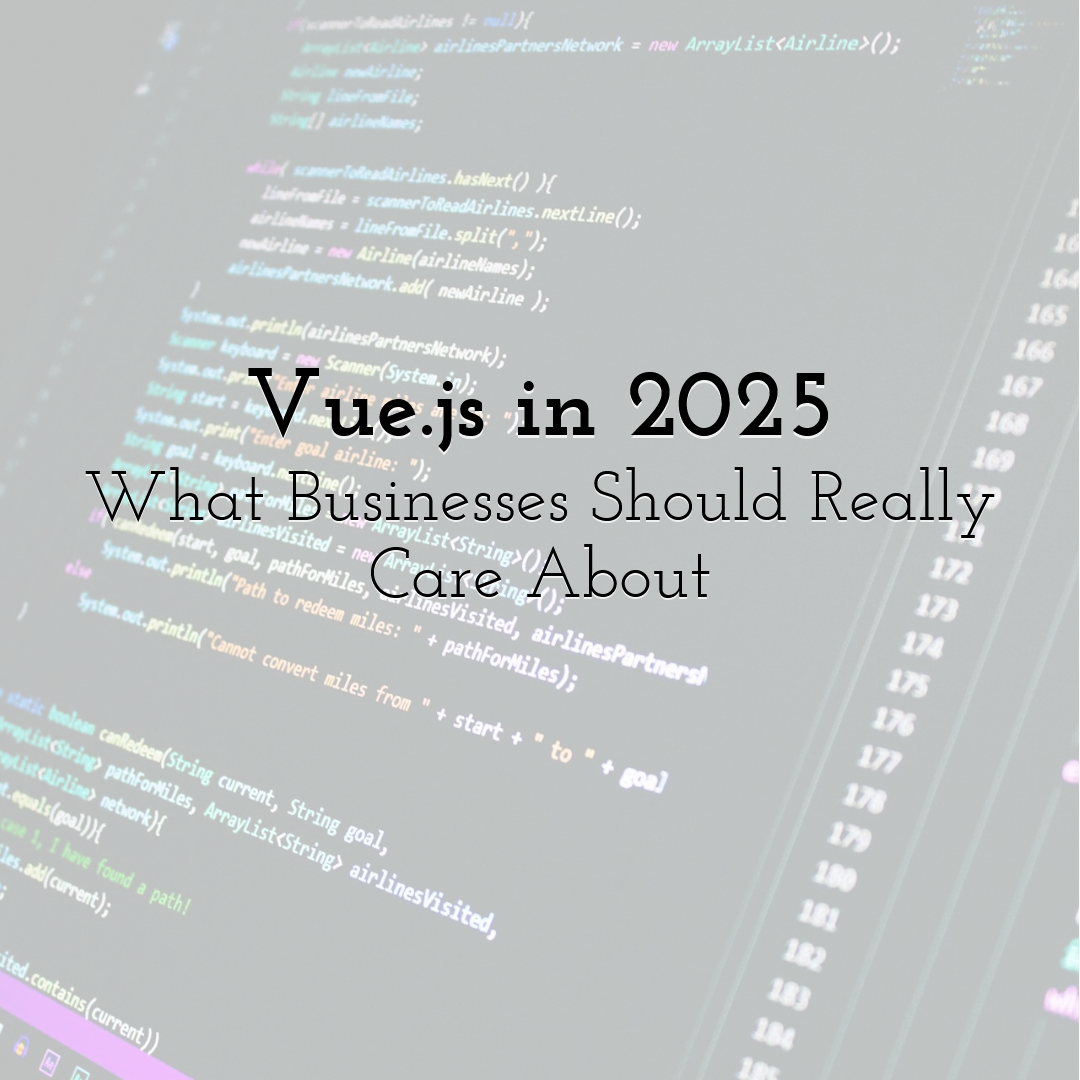Vue.js in 2025: What Businesses Should Really Care About

You learn that frameworks come and go if you build for the web long enough. However, some frameworks keep getting better without getting more complicated. Vue.js is one of those rare tools. In 2025 it still feels approachable for small teams, yet it powers ambitious products with complex state, fast user interfaces, and clean code structure. The question for companies is not “Vue or React” anymore. It is “How do we ship faster, safer, and smarter with the stack we trust?” Vue’s recent moves answer that with a focus on performance, type safety, server rendering, and a developer experience that frees teams to focus on real product work.
Vue is a great choice if your plan includes updating a dashboard, creating a design system, or going toward edge rendering. For a lot of teams, it also makes sense to hire a partner who knows this ecosystem inside and out, like a custom Vue.js development company that can help you make sure your architecture choices are right, speed up difficult migrations, and keep quality high while your internal team focuses on the most important business needs.
Why Vue.js is Still Important in 2025

Vue wins because it stays human. The single file component pattern is easy to reason about. The Composition API gives you power without forcing boilerplate. And the surrounding tools have matured without getting bloated. In 2025, several forces make Vue especially compelling for companies:
- • Stable evolution, not churn. You can adopt features like script setup, Suspense, and SSR improvements at your own pace.
- • First class TypeScript. Strong typing used to be a chore in Vue. It is smooth now, and it pays off with safer refactors.
- • Nuxt at the core. Nuxt 3 made server rendering, static generation, and hybrid modes realistic for teams that do not want to spend months wiring up a meta framework.
- • Vite everywhere. Instant dev servers and fast builds change how teams work. It's no longer okay to have to wait minutes to recompile.
For people who work in business, that means quicker lead times, fewer bugs, and a frontend that can keep up with new product ideas.
Trend 1. Server Everything Without Slowing Down
In 2025 server rendering is not an optional “SEO mode.” It is the default for fast time to first byte and for shipping personalized content at scale. Vue’s SSR story has matured in three directions that matter:
- 1. Hybrid rendering. You can mix static generation for evergreen pages, server rendering for dynamic routes, and client hydration for interactive modules. Nuxt makes this feel natural, not like three separate codebases.
- 2. Islands architecture. Instead of hydrating a massive app shell, you can render only the interactive parts. This keeps CPU usage on low powered devices under control and makes your site feel instant.
- 3. Edge ready deployments. With adapters and serverless friendly patterns, Vue apps can render closer to users. That reduces latency for global audiences and improves conversion on critical flows.
What to do next: audit your routes, define which ones are static, which are dynamic, and which can become islands. Then pick a single deployment target and lock it. Too many teams waste time jumping between serverless providers without setting clear performance budgets.
Trend 2. Type Safe By Default
TypeScript used to be an optional layer for Vue projects. Now it is a competitive advantage. Typed props, emits, and stores reduce entire classes of bugs. The Composition API works beautifully with generics, and tooling has caught up so you get meaningful hints in the editor instead of noise.
A practical approach that works for most companies:
- • Start new libraries and shared components as TypeScript first.
- • Incrementally type legacy views where bugs cluster.
- • Use Vitest for unit tests because it integrates well with Vite and feels fast enough to run on every commit.
You will notice that onboarding becomes easier. New engineers can explore the codebase with confidence because types communicate intent better than comments.
Trend 3. Design Systems That Do Real Work
Design systems are only useful when they are used. Vue’s reactivity model and slot based composition make it natural to build components that are flexible without being leaky. In 2025, the winning pattern is to treat your system as a product, not a repository:
- • Ship a playground and documentation site from day one
- • Track adoption inside each product team.
- • Provide escape hatches for experiments, but require a path to merge back into the system.
Companies that do this report fewer “snowflake” components, faster page builds, and a more consistent user experience across apps. If you are starting fresh, aim for a token based setup that maps directly to your brand primitives like colors, spacing, and typography. Keep tokens source controlled and shared across web and native.
Trend 4. Performance Budgets You Actually Enforce
Performance turns from “nice to have” into revenue when you operate in competitive markets. Vue alone will not save you if you keep shipping 5 MB bundles. The good news is that the ecosystem gives you realistic tools to keep things lean:
- • Vite code splitting and dynamic imports.
- • Route level prefetching only when users show intent.
- • Image optimization integrated into your build.
- • Telemetry that flags regressions before a release.
Set budgets per route. For example, “logged out landing route stays under 150 KB compressed, LCP under 2.5 s on mid tier devices.” Tie those budgets to CI checks and make the system fail loudly when you exceed them. This creates the right incentives without constant human policing.
Trend 5. AI Enhanced Tooling Without Hype
Yes, “AI for frontends” is often overpromised. But in Vue land there are grounded wins today:
- • Scaffold components from stories. Feed your component use cases and let a tool draft boilerplate tests, basic props, and docs. Engineers refine the result instead of starting from zero.
- • Generated migrations. When APIs change, smart codemods can update 80 percent of the surface automatically and leave clear TODOs for the rest.
- • Content helpers. For marketing sites, models can make alt text and meta descriptions that are customized and follow your brand's rules.
AI should be used to speed up jobs that need to be done over and over, not as a creative director. The creative and architectural calls still belong to your team.
Trend 6. Backend Friendly Frontends
The line between frontend and backend keeps blurring, and Vue is comfortable in that middle ground. Server actions, edge functions, and API routes help you ship small features without spinning up a separate service. Two healthy patterns to consider:
- • Use server routes for narrow, low risk tasks like contact forms, simple webhooks, or email triggers.
- • Keep critical business logic in a dedicated service with clear contracts. Consume it from Vue through a typed client.
This hybrid approach keeps the UI team productive while respecting long term maintainability.
How To Decide If Vue Is The Right Bet For A Project

This is a short checklist that cuts through all the noise:
- • Your team values a gentle learning curve but needs room to scale.
- • You want SSR or hybrid rendering without heavy custom plumbing.
- • You care about bundle size and dev server speed in daily work.
- • You plan to build a shared component library for multiple products.
- • You prefer a framework that evolves steadily rather than chasing trends.
If you tick most of these boxes, Vue is a strong fit. If your company runs deep React expertise and owns a large React design system, the migration tax may not be worth it unless you face a major rewrite anyway.
A Simple Migration Path That Respects Reality

Many companies are not starting from scratch. They have a legacy app that brings revenue today. Here is a pragmatic, low risk path that I have seen work:
- • Pick one user flow where performance or maintainability hurts.
- • Rebuild that flow in Vue behind a feature flag. So you can compare like with like, don't change the data.
- • Set goals for success, such as conversion rate, time to interactive, and error rate.
- • Roll out gradually and watch the numbers. If results are neutral or better, expand to the next flow.
- • Retire old code as you go. Avoid running two full stacks forever.
This approach builds confidence inside the company and gives real data to guide the next step.
What To Measure After You Ship

If you don't measure it, you can't make it better. After launching a Vue powered feature or site, watch these signals:
- • Core Web Vitals at the route level, segmented by device class.
- • Error rates with a focus on hydration and SSR mismatches.
- • User paths to confirm that faster pages actually drive more completion.
- • Dev velocity measured in cycle time from ticket to production.
It's okay to praise winners, but not to blame losers. It should be seen as a problem with the system, and the tools or process should be changed to fix it.
Final Thoughts:
Vue.js is not a strange choice in 2025. It is a stable, modern, and performance minded framework that helps teams ship high quality interfaces without drowning in ceremony. If you keep an eye on server rendering, type safety, design systems, and real performance budgets, you will get most of the gains companies are chasing this year. You can get things done faster or be sure you're making the right option in just a few lessons instead of months of trying things out and failing when you work with specialists.
The greatest technique to perform well stays the same, even though the web is continually evolving. Ship in little pieces, keep track of what's vital, and always make sure that your technological decisions are based on what your customers desire. Don't squander your team's time. Vue fits with that way of thinking right now, which is why so many businesses are quietly switching to it as the buzz dies down.
Until next time, Be creative! - Pix'sTory

